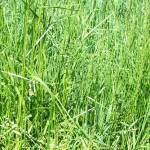Fescue Toxicosis in Mares: How Much Ergovaline Is Too Much?

Researchers established the effects of endophyte-infected tall fescue on late-term pregnant mares long ago: prolonged gestation, thickened placenta, oversized foals, difficult births, and little or no milk production. The endophyte produces chemicals called alkaloids that have distinct, and oftentimes toxic, pharmacological effects. The alkaloid in highest concentration in endophyte-infected fescue is ergovaline, which is a vasoconstrictor known to compromise circulation to the hooves.
Researchers at the University of Kentucky measure endophyte and ergovaline, as well as pasture species composition, to calculate ergovaline in broodmare pastures.* Though no exact threshold of ergovaline in the total diet has been established for broodmares, the University of Kentucky uses 200 ppb as an accepted threshold value because mares demonstrated constriction of the distal palmar artery at this level. The distal palmar artery supplies blood to the hoof, and palpation of this artery is performed to assess digital pulse.
The risk for late-term pregnant mares grazing pastures in the 201-500 ppb range is moderate but, according to the researchers, this risk can be diminished by reducing ergovaline in the diet through pasture management, such as mowing to remove infected seedheads but still maintaining a grazing height of about 15 cm (6 in), as ergovaline concentrates at the base of plants. Pastures over 500 ppb are unsafe for late-term pregnant mares.
Aside from lab tests to determine the level of endophyte and ergovaline, the amount of tall fescue in a pasture can help dictate management decisions, though consultation with the attending veterinarian is also warranted. A professional agronomist who specializes in grazing plants can help determine pasture composition measurements.
- If tall fescue is less than 10% of pasture, there is little risk to late-term pregnant mares, except during severe stress periods when the tall fescue might grow but other species become dormant.
- If tall fescue is 10-25% of pasture, risk is slight but safe pregnancy is not guaranteed. Mares should be watched carefully if the last 60-90 days of gestation occur in March and April (or November and December for Southern Hemisphere breeders).
- If tall fescue is 25-50% of pasture, risk to late-term pregnant mares is significant, especially during stress periods. Most managers would elect to remove mares from this pasture 60-90 days prior to due date.
- If tall fescue is 50-100% of pasture, risk is high, and mares should be removed from pasture during the last 60-90 days of gestation.
Depending on the composition of a given pasture, an agronomist might recommend overseeding, chemical weed control, tall fescue mitigation, or complete renovation of pasture.
New cultivars of tall fescue that contain a novel endophyte have been developed. These cultivars produce alkaloids that imbue the plant with desirable plant characteristics, such as drought tolerance and insect resistance but do not produce the alkaloids that are harmful to late-pregnant mares.+
In addition to good-quality forage and concentrate, many broodmares benefit from targeted supplementation to support reproductive processes, including provision EO-3, a source of the long-chain omega-3 fatty acids known as EPA and DHA, and Nano-E, a natural-source vitamin E
*Lea, K.L.M., and S.R. Smith. 2021. Using on-farm monitoring of ergovaline and talk fescue composition for horse pasture management. Toxins 13:683.
+McDowell, K., V. Taylor, T. Phillips, K. Lea, R. Smith, G. Aiken, and M. Barrett. 2019. Pregnant mares grazing a novel endophyte-infected tall fescue foal normally. Journal of Equine Veterinary Science 74:56-64.








